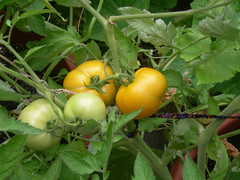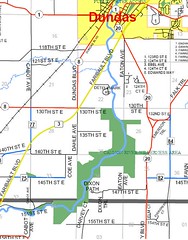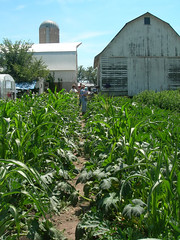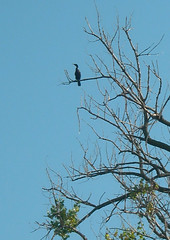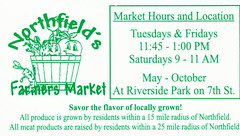
This is it... my garden. I've never had a huge garden, and some years I've had no garden at all, but this year what it amounts to is five varieties of tomato and two varieties of cucumber in six pots on the southwest-facing patio of my current residence. Oh, and some parsley, basil and chives in windowsill pots. I've been picking cucumbers and the occasional tomato for a couple of weeks now.
I love eating out of my garden. And I've decided to start eating more sustainably in general. For me, right now, that involves a real commitment to shop regularly at the local farmer's market, to spend more of my grocery dollars at the
local co-op, and to let my local supermarket know that I am interested in supporting local produce and other farm products. I'm going to participate in the co-op's Eat Local challenge next month (August 15-September 15), striving to make 80% of my food choices from our five-state area (Minnesota, Wisconsin, Iowa, and North and South Dakota). I'll share my progress here. I don't mean to be fanatic about it, but I think I can do some good for the local land, the global environment, and the local economy by making some conscious choices about how and what I eat. When it can't be local, at least I'll try to choose organic or minimally processed options.
Eating more fresh, local food necessarily requires preparing it. Along the way I'll share some recipes and menus and musings about food in general.
I don't come new to an interest in this kind of thing, but due to things like my transition from part-time work while my kids were younger to full-time work, plus a divorce and subsequent move to rental property (at least for the next couple of years), I've let it slip. But I've just read Barbara Kingsolver's new book,
Animal, Vegetable, Mineral, about her family's experiences eating almost entirely locally in rural Virginia for a year, and I'm all fired up again. So, here goes.
In my kitchen this week:
- New potatoes (white and red) from the farmer's market
- Early zucchini (ditto)
- Low-sugar strawberry jam I made a couple of weekends ago from the flat of local strawberries my older daughter gave me. It's almost more of a sauce, with a 4:1 fruit-to-sugar ratio and no added pectin. It's soft and intensely strawberry-y, and delicious on buttered bread.
- 10-grain bread from one of our two local bakeries
- Cucumbers and tomatoes from the garden
- Milk, yogurt, sour cream, butter and cheese from Minnesota and Iowa dairies
- Organic eggs from Owatonna, MN
Simple July potato salad:Boiled and sliced new potatoes, with skins left on
Sliced cucumbers
Newman's Own Oil & Vinegar dressing (a perennial favorite)
Crumbled feta cheese
Gently toss, add some salt & pepper to taste, and that's it.
